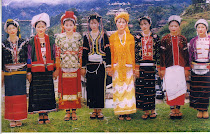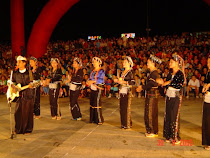
ယခုပေလာင္ေလးဘေလာ့သို့လာေရာက္လည္ပတ္ခဲ့သည့္ အာလံုးေသာ မိတ္ေဆြ ညီအစ္ကို ေမာင္ႏွမ မ်ားစြာအတြက္ ေပ်ာ္ရြင္မွ ု၊ေက်နပ္မွ ု၊ လိုအပ္မွ ုေတြနွင့္ ေႏြးေထြးမွ ုမ်ား ျဖည့္ဆည္းေပးႏိုင္ရန္ အတြက္ သီခ်င္းမ်ား၊ဗြီဒီယိုမ်ား၊ ဓါတ္ပံုမ်ား၊ကဗ်ာမ်ား၊ အျခားအေတြးအျမင္ မ်ားစြာ ကို ေပ်ာ္ရြင္မွ ုတစ္ခုအေနျဖင့္ စုစည္းတည္ေဆာက္ထား ေသာ ဘေလာ့ျဖစ္ပါတယ္။
ပေလာင္ေလး ဘေလာ့သို ့ ဗဟုသုတ ရွာေဖြရန္ အတြက္ေသာ္ လည္းေကာင္း၊ ေပ်ာ္ရြင္မွ ုရွာေဖြရန္ အတြက္ေသာ္လည္းေကာင္း၊ အပ်င္းေျပဖို ့ အတြက္ေသာ္ လည္းေကာင္း လာေရာက္ လည္ပတ္လာၾကသည့္ အားလံုးေသာ္ မိတ္ေဆြ သဂၤဟ စာဖက္ ပရိတ္သက္ ေတြကို ၀မ္းေျမာက္စြာ ၾကိဳဆို ပါသည္။က်ေတာ့္ ပေလာင္ေလးဘေလာ့အတြက္ အၾကံေပးလိုသူေတြ၊ ေ၀ဖန္ သံုးသပ္ သင္ျပ သူေတြ အားလံုးကိုလည္း အစဥ္အျမဲ ၾကိဳဆို လက္ခံပါသည္။
အခုလို မိတ္ေဆြမ်ား၏ အက်ိဳးရွိေသာ အခ်ိန္တြင္ က်ေတာ့္ "ပေလာင္ေလး" ဘေလာ့ ကို လာေရာက္လည္းပတ္ခဲ့သည့္ အတြက္ ပေလာင္ေလး မွ အထူးပင္ ေက်းဇူးတင္ပါသည္။
အားလံုး ေပ်ာ္ရြင္ခ်မ္းေျမ့နိုင္ပါေစ.......................
- History of Palaung (1931)
- Orientation

- Identification. While the name "Palaung" is Burmese in origin, the Palaungs call themselves "Ta-ang," along with several dialectal variants of that name. They are known as "Palong" as well as "Kunloi" (mountaineer) by the Shans. The name "Rumai" or "Humai" is occasionally applied to all Palaungs but actually refers specifically to one of their subgroups.
Rumai, Humai ,Kunloi ,Dang,Ta-ang
Language family: Austroasiatic
Language branch: Mon-Khmer
- Location. The Palaungs are found in the Shan States of east central Myanmar (Burma) with the majority found in Taungpeng State (approximately 23° N and 97° E). They are also in the adjacent states of Hsipaw, North and South Hsenwi, Möngmit, and as far south as the Shan State of Kengtung. Palaungs are also reported in the southern part of Kachin State and in southwestern Yunnan, China. They occupy a region of ridges up to 2,000 meters, separated by narrow valleys. In addition to cultivated lands, there is some open grassland, but the upper elevations are mostly temperate forest. The climate is typical continental Southeast Asian monsoon, with rainy summers and dry winters.
- Demography. While there is no available population estimate for Palaungs in Myanmar today, in 1931 the total Palaung population was estimated at 140,000.
 Linguistic Affiliation. The precise linguistic classification of Palaung has not yet been determined; it is however agreed that the various dialects of the Palaung language belong to the Mon-Khmer Group in the Austroasiatic Family. In the literature the Palaung are often associated with the Wa, another northern upland Mon-Khmer group, and they may appear cited as a single group, the Palaung-Wa. There appears to be no close affiliation between them, however, and it is reported that the two groups do not recognize any affiliation.
Linguistic Affiliation. The precise linguistic classification of Palaung has not yet been determined; it is however agreed that the various dialects of the Palaung language belong to the Mon-Khmer Group in the Austroasiatic Family. In the literature the Palaung are often associated with the Wa, another northern upland Mon-Khmer group, and they may appear cited as a single group, the Palaung-Wa. There appears to be no close affiliation between them, however, and it is reported that the two groups do not recognize any affiliation.
- History and Cultural Ralations
- The Palaungs probably preceded Shan and Kachin settlement of the east central and northeast region of Myanmar. During the nineteenth century Taungpeng, the political focus of the Palaungs, was marginal to the neighboring Shan principalities and its relationship to the Burmese state was even more marginal. Although there were tributary relations and trade with the Burmese, the greatest cultural influence on the Palaungs appears to have been that of the Shans. Although there are Burmese loanwords in Palaung, the Shan language is both the written language of the Palaung and the lingua franca not only between Palaungs and Shans, Kachins, and other neighbors, but also between Palaung dialect groups.
Palaung history
In the nineteenth century, the British colonial rule recognized the Palaung-controlled kingdom of Tawnpeng, and the Palaung enjoyed far more freedom and power in terms of land ownership and political influence in then Burma than of recent.
The Palaung armed themselves against the military junta in 1963 with the creation of the Palaung State Liberation Army (PSLA), the military arm of the political liberation movement, to demand more autonomy.
In 1991, under intense pressure from the military regime and its brutal methods, and with a growing number of other ethnic opposition groups rendering arms, the SPLA signed a ceasefire with the SLORC [1].
As a result, some diverging Palaung factions formed the Palaung State Liberation Front (PSLF) in 1992 to continue their armed opposition and demand self-determination, democracy and human rights for Palaung people.
They are cooperating with the pro-democracy movement of Aung San Suu Kyi and other ethnic opposition groups to secure peace talks with the junta. အျပည့္အစံု ဖက္ရန္
.............................................................................................................................................................................



အျပည့္အစံုံု
............................................................................................................................................................................
ပ
မိုင္းမိုင္း












